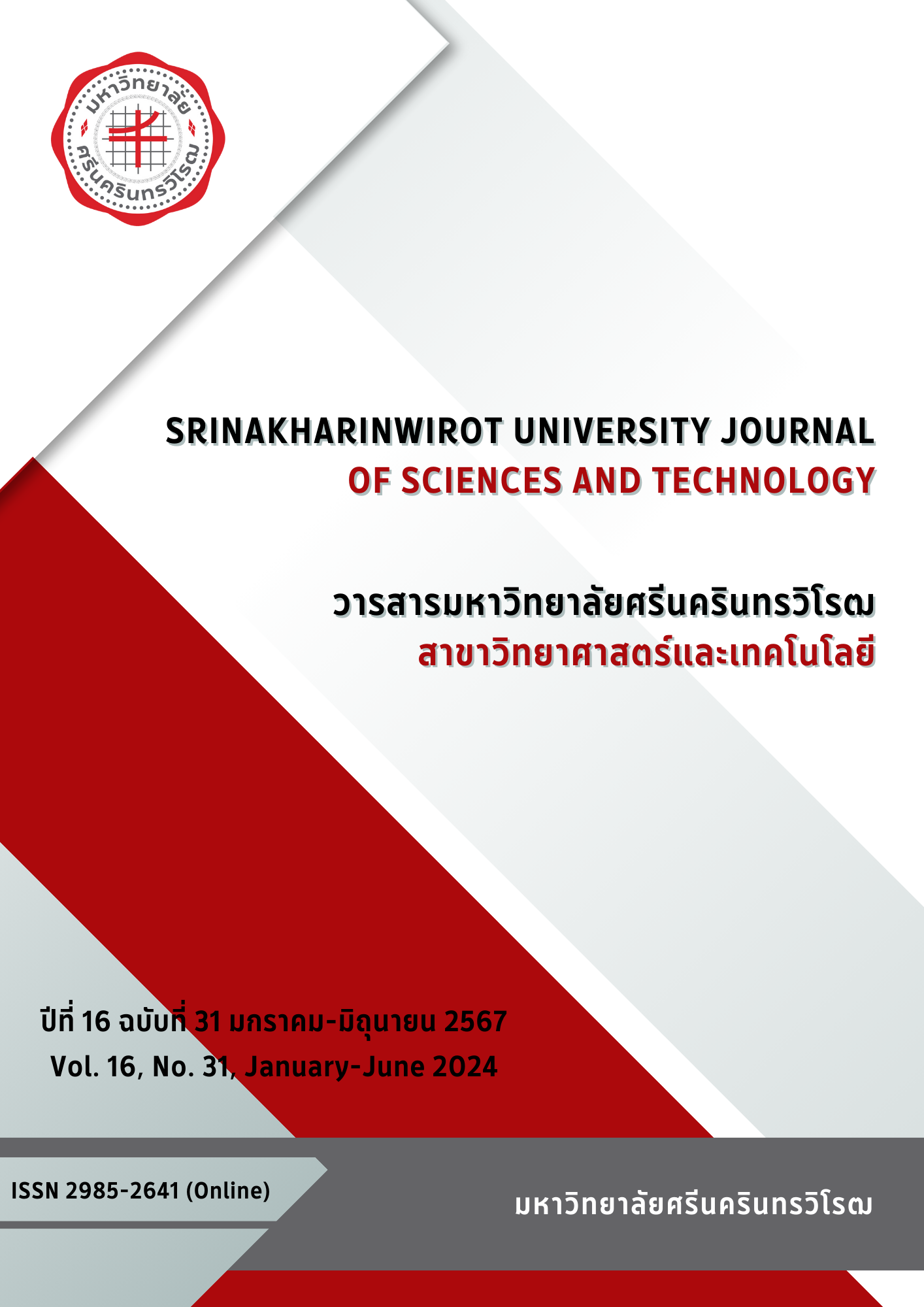METHOD DEVELOPMENT FOR METAL ANALYSIS USING BOUGAINVILLEA FLOWER EXTRACTS AND ULTRAVIOLET-VISIBLE SPECTROSCOPY TECHNIQUE
Keywords:
Bougainvillea Flower, Metal Analysis, Environmentally Friendly, UV-Vis SpectroscopyAbstract
This research aims to develop a method for metal analysis with Bougainvillea flower or paper flower extracts and Ultra-Visible spectroscopy techniques. The paper flower extracts that used in this study were extracted with buffer solution. The chemical structure of paper flower extracts was determined by Fourier transform infrared spectroscopy (FT-IR) technique. The result showed that the functional groups of paper flower extracts were similar to betanin standard that produced from beetroot. The optimum condition for metal analysis with developed method included the buffer solution (pH 7) that used as extraction solvent, the concentration of betanin in paper flower extracts of 2.8 grams per liter. The reaction time was 10 minutes. The linearity range of nickel standard solution was 2.5-40 milligrams per Liter. This method was detected at the wavelength of 536 nanometer. The limit of detection was 2.92 milligrams per liter. The linear equation was y = -0.0045x+0.6096. The coefficient of determination (R2) was 0.9857. The relative standard deviation of reproducibility and repeatability were 0.65 and 0.18 percentage, respectively. The recovery was 91-96 percentage. The result of nickel content in synthetic wastewater from developed method showed correlated with Flam-AAS technique. This developed method is simple, rapid, cheap and environmentally friendly.
Downloads
References
Khairy, M., Ismael, M., El-Khatib, R. M., Abdelnaeem, M., and Khalaf, M. (2016). Natural betanin dye extracted from bougainvillea flowers for the naked-eye detection of copper ions in water samples. Analytical Methods, 8, 4977-4982.
Yao, Z., Yang, Y., Chen, X., Hu, X., Zhang, L., Liu, L., Zhao, Y., and Wu, H.-C. (2013). Visual detection of copper (II) Ions based on an anionic polythiophene derivative using click chemistry. Analytical Chemistry, 85, 5650-5653.
Adebayo, B. K., Ayejuyo, S., Okoro, H. K., and Ximba, B. J. (2011). Spectrophotometric determination of iron (III) in tap water using 8-hydoxyquinoline as a chromogenic reagent. African Journal of Biotechnology, 10(71), 16051-16057.
Stalikas, C. D., Pappas, A. Ch., Karayannis, M. I., and Veltsistas, P. G. (2003). Simple and selective spectrophotometric method for the determination of iron (III) and total iron content, based on the reaction of Fe(III) with 1,2-dihydroxy-3,4-diketocyclo-butene (squaric acid). Microchimica Acta, 142, 43-48.
Khaodee, W., Wongkiti, R., and Madang, S. (2017). Naked-eye detection of lead ion in water sample using reagent extracted from white dragon fruit peel. KKU Science Journal, 45(4), 886-895.
Settheeworrarit, T., Hartwell, S. K., Lapanatnoppakhun, S., Jakmunee, J., Christian, G. D., and Grudpan, K. (2005). Exploiting guava leaf extract as an alternative natural reagent for flow injection determination of iron. Talanta, 68(2), 262-267.
Saowongchan, K., and Mancharoen, S. (2019). Development of quantitative analysis technique for Fe(III) using natural anthocyanin extract detected by smartphone. Science and Technology Journal, 28(8), 1372-1388.
Sukaram, T., Sirisakwisut, P., and Chaneam, S. (2017). Use of natural pigment from orchid as a reagent for quantitative analysis of ammonia in chemical fertilizers. Burapha Science Journal, 22(4), 366-376.
Killedar, S., Pawar, A., Nadaf, S., Nale, A., Tamboli, U., and Pishawikar, S. (2014). Novel analytical method development for some amide group containing drugs using Bougainvillea spectabilis bract extracts. Asian Pacific Journal of Tropical Medicine, 7(Supplement 1), S560-S567.
Azeredo, H. M. C. (2009). Betalains: Properties, sources, applications, and stability - A review. International Journal of Food Science and Technology, 44, 2365-2376.
Kumar, S. N. A., Ritesh, S. K., Sharmila, G., and Muthukumaran, C. (2017). Extraction optimization and characterization of water soluble red purple pigment from floral bracts of Bougainvillea glabra. Arabian Journal of Chemistry, 10(Supplement 2), S2145-2150.
Wybraniec, S., Starzak, K., Skopińska, A., Szaleniec, M., Słupski, J., Mitka, K., Kowalski, P., and Michałowski, T. (2013). Effects of metal cations on betanin stability in aqueous-organic solutions. Food Science and Biotechnology, 22, 353-363.
Downloads
Published
How to Cite
Issue
Section
License
Copyright (c) 2024 Srinakharinwirot University Journal of Sciences and Technology

This work is licensed under a Creative Commons Attribution-NonCommercial-NoDerivatives 4.0 International License.
Srinakharinwirot University Journal of Sciences and Technology is licensed Under a Creative Commons Attribution-NonCommercial-NoDerivs 4.0 International (CC-BY-NC-ND 4.0) License, Unless Otherwise Stated. Please Read Journal Policies Page for More Information on Open Access, Copyright and Permissions.



